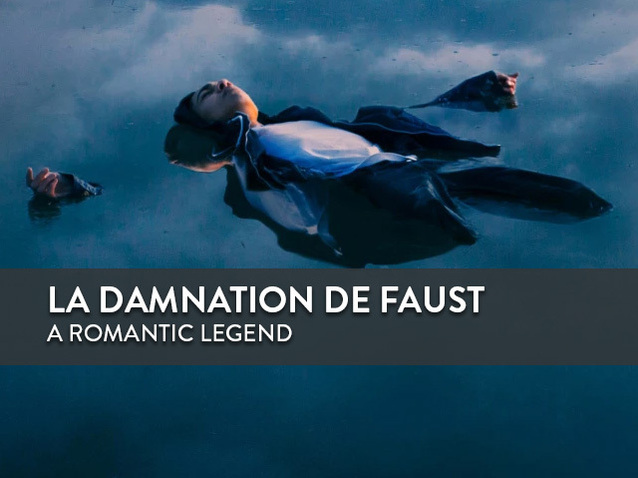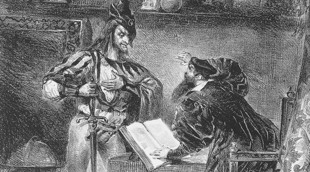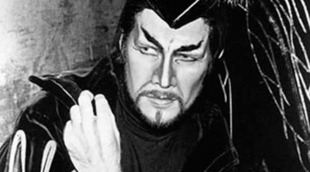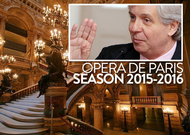 © DR
© DR
Originally subtitled “concert opera” and later “legend-opera”.La Damnation de Faust was subsequently dubbed by Berlioz a “dramatic legend in four parts”.This indecision reflects the unclassifiable and protean nature of a work that is a succession of independent tableaus each belonging to a different genre.Fascinated by Goethe’s Faust, which he discovered in the translation by Gérard de Nerval, Hector Berlioz immediately took an interest in the metaphysical and moral torments of Doctor Faust.Torn between his quest for the absolute and his desire to live intensely in order to escape the terrible feeling of what Berlioz himself called “isolation sickness”, Faust signs a pact with the Devil.The composer projected himself into the moral suffering of this character who went on to inspire so many other musicians:Gounod (Faust, 1859), Schumann (Scenes from Gioethe’s Faust, 1862), Liszt (Faust Symphony, 1857), Boito (Mefistofele, 1868) and, much later, Busoni (Doktor Faust, 1925).La Damnation de Faust was created over time and in various places, taking shape gradually through the various stages of its composition, from the Eight Scenes from Faust published in 1829 to the very last note written on 19 October 1846.In his Mémoires, Berlioz notes that he finished the score “at the café, at the Tuileries Gardens, and on a bollard on the Boulevard du Temple”.This raises a question:what solution should be adopted in presenting this masterpiece of French musical romanticism to the public?Was a theatrical staging necessarily the best option?Today the work is often performed in concert version, which jibes with the fact that Berlioz never explicitly intended it for the stage.After the stinging failure he had encountered with Benvenuto Cellini (1838), the composer hesitated to begin composing another opera; he preferred to look for solutions to replace a genre he did not want and whose formalism and routine as imposed by the Paris Opera he objected to. The lack of a plot and the relative eclipse of the characters in the face of an orchestral mass that carries the drama along make La Damnation de Faust a work freed from the constraints that might curb the composer’s imagination and that of the listener:“Music has great wings that the walls of a theatre keep from fully extending.”Everything seems to happen within an imaginary space marked by unpredictability, unreality and mobility, for we are above all asked to share Faust’s inner torments.This is an imaginary musical theatre that lends itself to the daring conception of a stage director as well as to the reveries of a listener being transported by the flamboyance and confidences of an orchestra elevated to the level of actor in the drama.
“In a coach, on the train, on steamboats”
Like a whole generation of young Frenchmen, Hector Berlioz (1803-1869) was excited when he read the translation by Gérard de Nerval of Goethe’s First Faust (1749-1832) in 1828:“The wonderful book fascinated me from the very start; I could not put it down; I read it constantly, at the table, in the theatre, in the street, everywhere.”Galvanized, the young, 25-year-old musician immediately undertook to put to music all the passages in verse, especially the ballads and love songs.In 1829, Berlioz had his Eight Scenes from Faust published; this was to be the core of the future Damnation de Faust.Goethe did not deign to respond when he received a copy of this first attempt, with which the musician was not completely satisfied.The lack of dramatic consistency in this succession of tableaus seems, curiously, to reflect the difficulties encountered by Goethe himself, who mixed prose and poetry while also claiming a formal freedom called for by the excess of his subject, the modern myth of the conquest of absolute wisdom and happiness. The German writer devoted sixty years to the torments of the fascinating alchemist. In the 1770s Goethe drafted his first version, called Urfaust.In 1808 Faust, First Part of the Tragedy appeared: this is the source of Berlioz’s La Damnation and Gounod’s Faust.It was not until the year of his death, at age 83, that Goethe finished the Second Part of the Tragedy, what is called the “Second Faust”.When Robert Schumann set about writing his Scenes from Faust, he adopted a fragmentary form, giving rise to another unclassifiable, open work, as if it were decidedly impossible to contain the legend of Faust, a rebellious character whose vital force defies common laws.

In approaching the works of Hector Berlioz, a first-hand account is available to us:these are the Mémoires that the musician began to write during his stay in London in 1848, displaying a talent as writer that we also find in his abundant work as music critic.
“It was during (this) trip to Austria, Hungary, Bohemia and Silesia that I began composing my ‘Faust’ legend, a plan I had been considering for a long time (…).So I tried, while rolling along in my old German poste chaise, to write the verses for my music.”
A picturesque account of the circumstances in which La Damnation de Faust was written puts us right in the heart of romanticism.From the musician’s nimble, image-rich pen came genre tableaus at the core of which we see the narrator composing the most striking scenes in his opera:“In Pesth, by the light of the gas lamp of a shop, one evening when I’d become lost in the city, I wrote the choral refrain for the peasants’ Ronde.”
One of the favourite themes of the Romantics, travel, seemed to embody the musician’s creative and aesthetic path.Berlioz again took up his old plan to create a Faust-based work during a trip he took in late 1842 and early 1843 to Germany, homeland of Goethe and his fascinating hero, which marked the origins of Romanticism:
“I wrote it (my score) when and where I was able; in a coach, on the train, on steamboats, and even in cities, despite the various duties imposed by the concerts I was to give there.And so at an inn in Passau, on the border with Bavaria, I wrote the introduction.”

Although he admired the poetic approach of Richard Wagner, who wrote his own opera librettos, Berlioz initially preferred to call upon the talents of a journalist, Almire Gandonnière, to give a definitive literary form to the Eight Scenes from Faust dating from 1829.For his part, Berlioz resumed writing his score during a concert tour in Central Europe beginning in October 1845.He composed his introduction in Passau, La Sérénade de Méphistophélès, Le Ballet des Sylphes and La Marche hongroise in Vienna, and theApothéose de Marguerite in Prague. The rather dizzying pace of the indefatigable traveller can be found in the very conception of La Damnation. Thus we move quickly from the plains of Hungary to Faust’s study in northern Germany, then from a cabaret in Leipzig to the perfumed banks of the Elba, and from Marguerite’s room to the thrilling vision of an “Immense, impenetrable and proud Nature” ( Scene XVI) with which Faust seeks to merge.
The composer followed the roundabout paths of his inspiration without considering the constraints of an opera hall reconnecting with the spirit of the programme symphony, a new genre in which he earned great fame by composing La Symphonie fantastique (1830). Berlioz invented a new form of dramatic work by asking the audience/spectators to follow the “meanderings” of his imagination as it busily rendered the inner progress of his hero.And when he was criticised for the dramatic inconsistency of his “opera”, he rebelled, stating his reasons with great sincerity in his Preface to the score:
“Why did the author, they ask, have his character go to Hungary?Because he wanted to use a piece of instrumental music with a Hungarian theme.He admits it sincerely.He would have taken him everywhere else if he had found the slightest musical reason to do so.”
In reality, this Marche Hongroise (Scene III) based on the theme of the Marche de Rakoczy is the only new piece that Berlioz added to his initial project.It was a huge hit in Budapest when it was created in February 1846.This choice tells us quite clearly that the musician’s goal was not to “resume” Goethe’s drama in order to “relate” to us in turn the adventures of Faust, the demonic magician and alchemist who is said to have lived in southern Germany between 1480 and 1540.
“Changing the masterpiece in a hundred different ways”?
"I was not obligated to follow Goethe’s plan, and the most eccentric travels can be attributed to a character like Faust without in any way clashing with plausibility.”
A great admirer of the “symphonic” operas of Carl Maria von Weber (1786-1826), Hector Berlioz entrusted to the orchestra the task of making the various places in the drama succeed one another with the speed and variety of a kaleidoscope.The interiority of the characters is also presented, thanks to an exceptional orchestral virtuosity.The variety of tones and colours the orchestra takes on was at the time unheard of in France.
Carried away by his inspiration, the composer ended up devoting himself entirely to his project, writing both text and music himself:
“I wrote the verses I still needed,” he confided in his Mémoires, “as the musical ideas came to me, and I composed my score with an ease I have rarely experienced with my other works.”

Returning to the sources of the first German Romantic, Berlioz translated all their key themes musically:the obsession with solitude, an implacably singular consciousness, the idealism and exaltation of love, the fantastic and the magical, the feeling of nature….The five pillars of Romanticism – travel, nature, love, night and death – are at the core of La Damnation de Faust.The work’s composite nature links it clearly to the aesthetic principles of Romanticism, among which is the blending of genres.
Just like Don Giovanni cast into the flames of Hell at the end of Mozart’s masterpiece, Faust is doomed to damnation in Berlioz’s opera.In the Preface to the Score, the musician distinguishes himself sharply from Goethe :“The very title of this work indicates that it is not based on the main idea in Goethe’s ‘Faust’, since Faust is saved in the famous poem.”Berlioz claimed the right to “change the masterpiece in a hundred different ways” to put it to music.This decision to deny Faust the redemption he had been granted by Goethe was roundly criticised by some.Berlioz was accused of having “mutilated a monument” by taking over a poem that exalted the myth of a hero enamoured of absolute wisdom and happiness.“La Course à l’abîme”was thus the biggest change in relation to Goethe’s intentions.In exchange for his promise to save Marguerite, condemned for the murder of her mother, Mephistopheles gets Faust to sign his diabolical pact.At the end of a fantastic ride, Mephistopheles leads Faust into the abysses of Hell, where he is condemned to serve the powers of evil (Scene XVIII).Above this cavalcade that makes use of all the resources of modern instrumentation and harmony, poignant modulations of the melody arise from an oboe.It is a reference to the “desperate voice” of Marguerite, serving as counterbalance to Mephistopheles, the one whose “ardent gaze penetrates like the flash of a dagger and which, like a flame, burns and devours the soul” (Scene V).At the start of Part Four (Scene XV), Marguerite evokes an equally ardent flame, that of love, which “consumes (her) fine days”.…The melancholy sound of the English horn heightens the searing beauty of this famous romance, the final appearance of the abandoned lover.Faust’s final aria in the following scene, the famous “Invocation to nature”, is a cruel response to the young woman’s despair.Faust, who is already out of love with Marguerite, now aspires to become one with the immensity of Nature, the only thing able to give him “respite from his endless ennui”.After the disillusions born of the adventures promised by Mephistopheles, who offered to give him “all that can be dreamed of by the most ardent desire” (Scene V), Faust glorifies Nature: “Upon your omnipotent bosom I feel my wretchedness less, I regain my strength, and I believe I am finally living” (Scene XVI).
If we look closely, we see that the resemblance between Goethe’s hero and Berlioz’s is greater than it appeared.In Faust, First Part of the Tragedy, which is Berlioz’s source, the hero imagined by Goethe is quite close to another of his characters, also overcome by “isolation sickness”, Werther.Moreover, Madame de Staël reproached this first Faust for his indecision, his lack of character and strength in the face of the Mephistopheles character, the master of ceremonies, the real hero of the drama who leads Faust to his perdition by constantly pushing him towards transgression.In La Damnation, Faust’s four monologues present every facet of the Romantic hero.Introspection and singularity, a feeling of absolute solitude, failure at the passion of love, and aspiration to annihilation are the same in Werther and Faust.At the start of Part Two, in the solitude of his study, Faust gives himself over to despair, not knowing whether he wants to be reborn or give himself over to death:
“Oh!I am suffering!I am suffering!(…) Where in the world can I find what is missing from my life?I would seek in vain; everything flees my bitter longing!Now, it has to end!...But I tremble…Why do I tremble before the abyss opened up before me?Oh, cup too long delighted by my desires (…), pour me the poison that is to enlighten or kill my reason.”
And it is when the Easter song seems capable of reconciling with the faith of his childhood that Mephistopheles bursts in to show him these “wonders” that will lead him ultimately to his loss.
An “unexpected indifference”
La Damnation de Faust was met with very little enthusiasm when it was presented at the Opéra-Comique on 6 December 1846.The public was disconcerted by the innovative aspect of his work.Was this a sort of symphony with singing, as it was described at the time in the famous Revue des Deux Mondes?Was it still possible to speak of “opera”, or was this an “oratorio”.In his Mémoires, Berlioz looks back at this failure:
“Nothing in my career as artist wounded me more deeply than this unexpected indifference.The discovery was cruel, but at least useful in the sense that I benefited from it, and since then, I have not wagered twenty francs on my faith in the Parisian public’s love for my music.”

Despite his efforts to ensure publicity for a work he had put his all into, the composer conducted before a half-empty hall.This failure brought about Berlioz’s ruin.La Damnation de Faust was never again performed in France while he was alive, whereas it was performed abroad, and well received, particularly in Weimar, Germany, thanks to the person to whom he dedicated the score, Franz Liszt.It was not until 1877 that Edouard Colonne and Jules Pasdeloup put La Damnation on the programme at Le du Châtelet where it was performed in its entirety.And more than fifty years after its first concert performance at the Opéra-Comique, the work was finally staged for the first time at the Monte Carlo Opera in 1893 with the encouragement of its director, Raoul Gunsburg (1860-1955). La Damnation became part of the Paris Opera’s repertory in 1910.
One of the loveliest Romantic scores, sometimes called a “monster” because of its hybrid and fragmentary nature, finally managed to establish itself on the world’s greatest opera stages, even though, in the words of Théophile Gautier, its composer had essentially intended it for our “ideal scene”.
Catherine Duault
the 28 of November, 2015 | Print



Comments